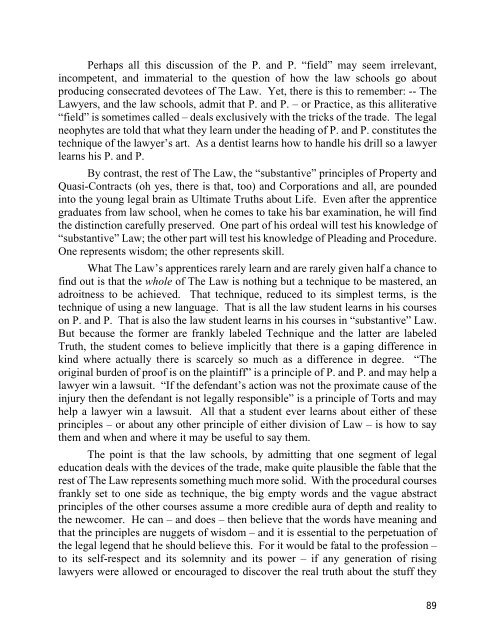WOE UNTO YOU, LAWYERS!
WOE UNTO YOU, LAWYERS!
WOE UNTO YOU, LAWYERS!
Create successful ePaper yourself
Turn your PDF publications into a flip-book with our unique Google optimized e-Paper software.
Perhaps all this discussion of the P. and P. “field” may seem irrelevant,<br />
incompetent, and immaterial to the question of how the law schools go about<br />
producing consecrated devotees of The Law. Yet, there is this to remember: -- The<br />
Lawyers, and the law schools, admit that P. and P. – or Practice, as this alliterative<br />
“field” is sometimes called – deals exclusively with the tricks of the trade. The legal<br />
neophytes are told that what they learn under the heading of P. and P. constitutes the<br />
technique of the lawyer’s art. As a dentist learns how to handle his drill so a lawyer<br />
learns his P. and P.<br />
By contrast, the rest of The Law, the “substantive” principles of Property and<br />
Quasi-Contracts (oh yes, there is that, too) and Corporations and all, are pounded<br />
into the young legal brain as Ultimate Truths about Life. Even after the apprentice<br />
graduates from law school, when he comes to take his bar examination, he will find<br />
the distinction carefully preserved. One part of his ordeal will test his knowledge of<br />
“substantive” Law; the other part will test his knowledge of Pleading and Procedure.<br />
One represents wisdom; the other represents skill.<br />
What The Law’s apprentices rarely learn and are rarely given half a chance to<br />
find out is that the whole of The Law is nothing but a technique to be mastered, an<br />
adroitness to be achieved. That technique, reduced to its simplest terms, is the<br />
technique of using a new language. That is all the law student learns in his courses<br />
on P. and P. That is also the law student learns in his courses in “substantive” Law.<br />
But because the former are frankly labeled Technique and the latter are labeled<br />
Truth, the student comes to believe implicitly that there is a gaping difference in<br />
kind where actually there is scarcely so much as a difference in degree. “The<br />
original burden of proof is on the plaintiff” is a principle of P. and P. and may help a<br />
lawyer win a lawsuit. “If the defendant’s action was not the proximate cause of the<br />
injury then the defendant is not legally responsible” is a principle of Torts and may<br />
help a lawyer win a lawsuit. All that a student ever learns about either of these<br />
principles – or about any other principle of either division of Law – is how to say<br />
them and when and where it may be useful to say them.<br />
The point is that the law schools, by admitting that one segment of legal<br />
education deals with the devices of the trade, make quite plausible the fable that the<br />
rest of The Law represents something much more solid. With the procedural courses<br />
frankly set to one side as technique, the big empty words and the vague abstract<br />
principles of the other courses assume a more credible aura of depth and reality to<br />
the newcomer. He can – and does – then believe that the words have meaning and<br />
that the principles are nuggets of wisdom – and it is essential to the perpetuation of<br />
the legal legend that he should believe this. For it would be fatal to the profession –<br />
to its self-respect and its solemnity and its power – if any generation of rising<br />
lawyers were allowed or encouraged to discover the real truth about the stuff they<br />
89


